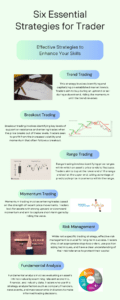
Strategies for Trader
Strategies for Trader Conduct thorough market research t

o identify potential markets, understand customer needs and preferences, and assess the competition. This will help you make informed decisions about which markets to target and how to position your products or services. Instead of trying to appeal to a broad market, consider segmenting your target audience into specific groups based on demographics, psychographics, or other relevant factors. By tailoring your marketing and sales efforts to these specific segments, you can increase the effectiveness of your trade strategies.Here are some common strategies for trade:
- Trend Trading: This strategy involves identifying and capitalizing on established market trends. Traders aim to buy during an uptrend or sell during a downtrend, riding the momentum until the trend reverses.
- Breakout Trading: Breakout trading involves identifying key levels of support or resistance and entering trades when the price breaks out of these levels. Traders seek to profit from the increased volatility and momentum that often follows a breakout.
- Range Trading: Range trading involves identifying price ranges within which an asset’s price tends to fluctuate. Traders aim to buy at the lower end of the range and sell at the upper end, taking advantage of predictable price movements within the range.
- Momentum Trading: Momentum trading involves entering trades based on the strength of recent price movements. Traders look for assets with strong upward or downward momentum and aim to capture short-term gains by riding the wave.
- Risk Management: While not a specific trading strategy, effective risk management is crucial for long-term success. Traders should set appropriate stop-loss orders, use position sizing techniques, and have a clear understanding of their risk tolerance to protect their capital.
- Fundamental Analysis: Fundamental analysis involves evaluating an asset’s intrinsic value by examining relevant economic, financial, and industry data. Traders who use this strategy analyze factors such as company financials, news events, and macroeconomic indicators to make informed trading decisions.


